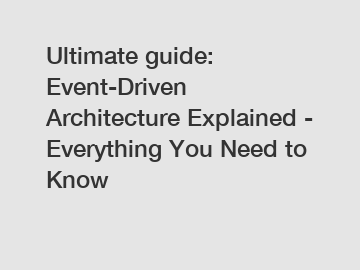Ultimate guide: Event-Driven Architecture Explained - Everything You Need to Know
Event-Driven Architecture Explained: Everything You Need to Know.
As technology continues to advance, organizations are constantly looking for ways to improve the efficiency and scalability of their systems. Event-Driven Architecture (EDA) has emerged as a popular solution for these challenges. In this ultimate guide, we will explore what Event-Driven Architecture is, how it works, and the benefits it can offer to your organization.
What is Event-Driven Architecture?

Event-Driven Architecture is a software design pattern that emphasizes the production, detection, consumption, and reaction to events that occur within a system. In an event-driven system, components communicate through events, which are asynchronous messages that represent a change in the system's state. This allows for a loosely-coupled architecture where components are independent and can operate independently.
How does Event-Driven Architecture work?
In an Event-Driven Architecture, events are generated by various components within the system, such as user interactions, system updates, or external triggers. These events are then published to an event bus, where they are delivered to one or more consumers who have subscribed to receive them. Consumers can react to these events by performing specific actions or triggering additional events in a decoupled and asynchronous manner.
Benefits of Event-Driven Architecture.
1. Scalability: Event-Driven Architecture allows systems to scale easily by distributing workloads across multiple consumers and processing events in parallel.
2. Flexibility: EDA enables organizations to adapt to changing business requirements by adding or modifying components without impacting the entire system.
3. Resilience: Due to its decoupled nature, Event-Driven Architecture can withstand failures in individual components without affecting the entire system.
4. Real-time processing: By reacting to events as they occur, organizations can build real-time data processing pipelines and enable faster decision-making.
5. Improved performance: EDA can help reduce latency and improve system performance by processing events asynchronously and in parallel.
Implementing Event-Driven Architecture.
To implement Event-Driven Architecture successfully, organizations should consider the following steps:
1. Identify events: Determine which events are critical to your system and how they should be structured and managed.
2. Choose the right tools: Select an event broker, such as Apache Kafka or RabbitMQ, to help manage and distribute events throughout your system.
3. Design event-driven components: Define event-driven components that can generate, publish, consume, and react to events within your system.
4. Monitor and manage events: Implement tools and processes to monitor the flow of events within your system and ensure reliable event delivery.
Conclusion.
Event-Driven Architecture is a powerful design pattern that can help organizations build scalable, flexible, and resilient systems. By embracing EDA, organizations can leverage real-time processing, improve performance, and adapt to changing business requirements. If you are looking to implement Event-Driven Architecture in your organization, consider the benefits and best practices outlined in this guide to help you get started.
Contact us to learn more about how Event-Driven Architecture can benefit your organization and support your digital transformation journey.
For more github event types, using kafka as a message queue, mq message queueinformation, please contact us. We will provide professional answers.
None

Comments